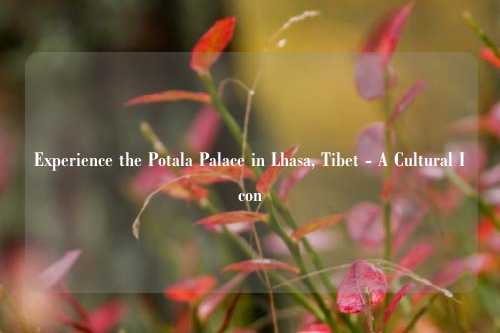Experience the Potala Palace in Lhasa, Tibet - A Cultural Icon
The Magnificent Architecture of the Potala Palace
Standing tall above the city of Lhasa, the Potala Palace is a stunning masterpiece of Tibetan architecture and one of the most iconic landmarks in Tibet. Perched on Marpo Ri Hill, this majestic structure is a symbol of Tibetan culture and Buddhist heritage. The Potala Palace, once the winter residence of the Dalai Lama, has been recognized as a UNESCO World Heritage Site since 1994, attracting millions of visitors each year.
The architectural design of the Potala Palace is an extraordinary feat of engineering, blending Tibetan, Nepalese, and Indian styles. The palace is a complex of white and red buildings spread across a sprawling site of more than 13 acres. Its towering structure reaches an impressive height of 117 meters (384 feet) and consists of 13 stories, with over 1,000 rooms, making it one of the most extensive palace complexes in the world. The palace’s design is a reflection of the spiritual and political power that the Dalai Lama once held in Tibet.

Historical Significance of the Potala Palace
The history of the Potala Palace dates back to the 7th century, when it was first constructed by King Songtsen Gampo, the 33rd king of Tibet. Initially built as a royal residence, it served as the seat of the Tibetan government and the headquarters for Tibetan Buddhism for centuries. However, it was under the reign of the 5th Dalai Lama, Lobsang Gyatso, in the 17th century, that the Potala Palace became the grand structure that we see today.
The palace was not only a place of governance but also a spiritual sanctuary. It was here that the Dalai Lamas governed Tibet and held religious ceremonies. Over the centuries, the Potala Palace became a symbol of Tibetan unity, power, and the deep relationship between the Tibetan people and their religious leaders. Its walls are imbued with a rich history, and the palace continues to be a symbol of Tibetan identity, despite the political changes Tibet has experienced in recent decades.
The Potala Palace as a Buddhist Center
At the heart of the Potala Palace is its religious significance. The palace is not only a royal residence but also a spiritual hub for Tibetan Buddhism. It houses numerous temples, chapels, and shrine rooms, all adorned with intricate carvings, murals, and statues that depict scenes from Buddhist texts and Tibetan history. These rooms are dedicated to Buddhist deities, including Avalokiteshvara, the Bodhisattva of Compassion, who is said to be the protector of Tibet.
One of the most important sections of the Potala Palace is the White Palace, which is primarily dedicated to administrative functions and housing the Dalai Lama’s residence. However, the Red Palace, which is more sacred, holds numerous chapels, reliquaries, and mummified remains of past Dalai Lamas. Visitors can witness Buddhist ceremonies and view the many relics and artifacts that tell the story of Tibet’s spiritual past.
The spiritual importance of the Potala Palace extends beyond its architecture and religious artifacts. Pilgrims from all over Tibet and neighboring regions undertake long journeys to visit the palace, which they regard as a place of profound spiritual enlightenment. For Tibetans, visiting the Potala Palace is seen as a form of devotion and respect for the Dalai Lama and their Buddhist traditions.
Art and Murals Inside the Potala Palace
One of the key highlights of the Potala Palace is its artwork, especially the beautiful murals that adorn the walls of many rooms and halls. These murals offer a window into Tibetan history, mythology, and Buddhist teachings. The paintings depict various scenes from the life of the Buddha, important historical events, and the lives of Tibetan kings and spiritual leaders. These vibrant, intricate murals are not only pieces of art but are also a form of visual storytelling, conveying the spiritual and political history of Tibet through the ages.
Another significant artistic element of the Potala Palace is the sculptures. The palace is home to hundreds of statues, many of which represent Tibetan deities, including Padmasambhava, Shakyamuni Buddha, and Manjushri. These statues are not only revered as sacred objects but are also masterpieces of Tibetan craftsmanship, showcasing the skill and artistry of local artisans throughout history.
The reliefs and carvings on the palace’s walls are equally impressive. These carvings often depict intricate scenes from Tibetan Buddhist lore, including Tantric rituals and meditative practices. The palace is a living testament to the importance of art and symbolism in Tibetan culture.
Exploring the White Palace and the Red Palace
The Potala Palace is divided into two main sections: the White Palace and the Red Palace, each serving a distinct purpose.
The White Palace
The White Palace was the administrative center of the Potala and the residence of the Dalai Lama. It is composed of numerous rooms, halls, and galleries, including the Assembly Hall and the Council Hall. The rooms in the White Palace are adorned with golden pillars, carved wood, and bright murals, all of which represent the palace’s secular function and the political power of the Dalai Lama.
The private quarters of the Dalai Lama are located within the White Palace, where visitors can catch glimpses of the living space of Tibet’s spiritual leader. These rooms are relatively modest compared to the grandeur of the palace, reflecting the humility of the Dalai Lama.
The Red Palace
The Red Palace is where the spiritual functions of the Potala Palace are carried out. It houses some of the most sacred temples and chapels in the complex, including the Chamber of the Dalai Lamas, where the tombs of several previous Dalai Lamas are located. The Red Palace is also home to some of the finest Tibetan murals, as well as many relics and holy texts. The Golden Tombs of the Dalai Lamas are among the most sacred and revered places within the Red Palace, where the mummified bodies of the past Dalai Lamas are preserved.
The Potala Palace as a Cultural Symbol
The Potala Palace is much more than just a historical monument or a religious site; it is a powerful symbol of Tibetan identity and culture. Despite facing political challenges and unrest in recent decades, the Potala Palace remains a source of pride for Tibetans. It stands as a representation of Tibetan independence, spiritual strength, and the enduring legacy of the Dalai Lama and his followers.
The palace also plays an important role in preserving and promoting Tibetan culture. Many visitors, both domestic and international, come to the Potala Palace not only to witness its grand architecture but also to learn about the Tibetan way of life, its traditions, and the struggles faced by the Tibetan people.
Visiting the Potala Palace: Practical Information
The Potala Palace is a must-visit destination for anyone traveling to Tibet. Here are some essential details to help you plan your visit:
Opening Hours:
The Potala Palace is typically open to visitors every day, except for major Tibetan holidays. The usual hours are from 9:00 AM to 4:00 PM, though hours may vary during the winter months. It is highly recommended to visit in the morning to avoid the crowds.
Ticket Prices:
Tickets for the Potala Palace can be purchased on-site or through official websites. The cost of admission generally ranges from 100 to 200 CNY (Chinese Yuan). Visitors are advised to book tickets in advance, especially during the peak tourist season.
Visiting Tips:
Altitude: The Potala Palace is situated at an elevation of 3,700 meters (12,140 feet) above sea level. Visitors should be aware of the altitude and take necessary precautions to prevent altitude sickness.
Dress Appropriately: As a religious site, the Potala Palace requires visitors to dress modestly. Avoid wearing short skirts, shorts, or revealing clothing.
Guided Tours: It is recommended to take a guided tour to fully understand the history, art, and significance of the Potala Palace.
Getting to the Potala Palace
The Potala Palace is located in the center of Lhasa, making it easily accessible from many parts of the city. Visitors can take taxis or local buses to reach the palace. For those arriving by train or plane, Lhasa’s Gonggar Airport is around 60 kilometers (37 miles) from the city center, and there are regular buses and taxis connecting the airport to the city.
The Potala Palace in Modern Tibet
Despite the political and social challenges that Tibet has faced, the Potala Palace remains an enduring symbol of Tibetan culture and spirituality. It stands as a reminder of the strength and resilience of the Tibetan people and their deep connection to their heritage.
















